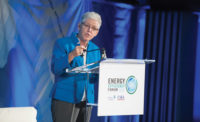According to the Department of Energy’s (DOE’s) Energy Infor-mation Administration (EIA), last January the spot price for natural gas peaked at $10.00 per thousand cu ft. The average wholesale price for 2001 is expected to be $4.16 per thousand cu ft. And the EIA is projecting that the wholesale price will stay below $3.00 per thousand cu ft through 2002.
Earlier this year, the price of oil was over $30.00 per barrel. The current level is about $18.00 per barrel. According to David Littmann, chief economist, Comerica Bank, Detroit, MI, “I think we’ll have another four months with the price below $20.00.” This is due, he said, “to the world’s economic slowdown and continued incentives to produce by the OPEC (Organ-ization of Petroleum Exporting Countries) and non-OPEC producers.”
Littmann feels these low energy prices “are having a very positive effect on the economy. For just the last two months alone, the savings in oil and natural gas is more than what Washington has given us in tax rebates.
“Going into the heating season, the natural gas prices will save approximately $165 per household. And the gasoline prices will save approximately $150 per driver,” said Littmann.
“So just in the four months ahead, where we are is a much better stimulus than the $300 tax rebates. And that augments consumer confidence and purchasing power.”
The impact of lower energy prices “gives us a greater cushion on the downside and prompts a recovery sooner.”
Littmann thinks these low prices are very conducive to growth, and coupled with other strengths he sees in the economy — “the fact that the consumer hasn’t really relinquished growth, just the rate of growth” — he says that the economy is already picking up and real growth could exceed 3% each quarter next year.
Finding The Right Supply
Explaining the natural gas situation, Peggy Laramie, spokeswoman for the American Gas Association (AGA), noted, “Last year at this time, natural gas prices were at very high levels and rising.” This was due “in part because the supply of gas was tighter in the summer of 2000 than it had been for many years. The amount stored was lower, in part because the price was higher. And then customers got hit with record cold around the country in November and December of 2000.”This combination “put greater pressure on prices,” driving them even higher last winter.
In the spring and summer, the situation reversed itself, responding to the market. “Natural gas producers went into overdrive, putting every piece of drilling equipment and every employee to work.”
But, Laramie said, because there was not sustained record heat around the country during the summer, not a lot of natural gas was used for electricity generation. And with the start of winter “kind of easing its way in” with warmer temperatures, “we’re not seeing the same kind of residential heating loads in many parts of the country that we had the same time last year.” With high supply comes lower prices.
The AGA, she said, “is increasingly frustrated by the fact that energy prices continue to reel around and swing from highs to lows in very short periods of time.” So the association is joining in calling on Congress to focus on establishing a national energy policy. “Because without certainty about how energy is going to be acquired and used well into the future, we’re sure it’s going to be hard for the U.S. economy to continue growing, and it’s going to be very difficult for businesses and customers to plan ahead in any logical way.”
The House of Representatives has already passed its comprehensive energy bill, “so we’ve been calling on the Senate to get a debate scheduled and perhaps include even more energy conservation,” she said. A focus on energy policy is needed as soon as possible “because without it, it will be increasingly difficult in the next few years to have stable energy prices.”
Laramie remarked that there have recently been reports that the number of active drilling rigs has been reduced, “so we can envision a situation where prices would begin to spike again.”
Don’t Forget Efficiency
Energy efficiency still needs to be stressed, emphasized David Hamilton, policy director, Alliance to Save Energy (ASE), and we shouldn’t be lulled into complacency, because it’s a certainty that low prices won’t last.“I hope that the past year has taught us something about the boom and bust nature of energy prices — that what is down this week or this year could be up again next week or next year,” he said.
“While short-term energy prices may be down, it’s still important to make investments in energy-efficient equipment so that we aren’t faced with another California.”
With the ongoing war on terrorism, and this country’s dependence on oil from the Mideast, if something should happen — for example, in Saudi Arabia — that materially affects the oil supply, “We could see a very sudden upward price spike,” Hamilton stated. “We now have to buffer our vulnerability to this.”
Maximizing energy efficiency should remain a priority, and it continues to be a high-yield investment for homeowners and businesses over the long term, he said.
“I think we’re in a highly volatile situation and the best move we can make is to insure ourselves against more shocks.”





